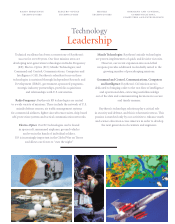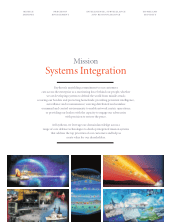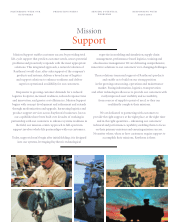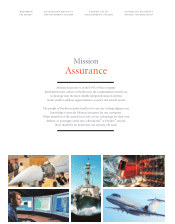Raytheon 2004 Annual Report Download - page 16
Download and view the complete annual report
Please find page 16 of the 2004 Raytheon annual report below. You can navigate through the pages in the report by either clicking on the pages listed below, or by using the keyword search tool below to find specific information within the annual report.
“The NCS team has figured it out. It’s all about building great
relationships with our customers and serving them so well
that they have absolute confidence and trust in the performance
of our systems and solutions.”
․․․․․․․․․․․․․․․․․․․․․․․․․․․․․․․․․․․․․․․․․․․․․․․․․․․․․․․․․․․․․․․․․․․․․․․․․․․․․․․․․․․․․․․․․․․․․․․․․․․․․․․․․․․․
The Long Range Advanced Scout Surveillance System (LRAS3) equipped the
U.S. Army’s infantry divisions in Iraq with a long-range surveillance and
targeting capability that supported coalition troops 24/7. The system has
been hailed by soldiers and commanders who call it “life-saving combat
equipment.” A large measure of this credit is owed to Raytheon field service
representatives whose dedication to customer mission success yielded dramatic
improvements in system readiness. The 3rd and 4th Infantry Divisions, the
Stryker Brigade Combat Team and the 1st Armored Division recognized their
achievement with awards and honors.
President
․․․․․․․․․․․․․․․․․․․․․․․․․․․․․․․․․․․․․․․․․․․․․․․․․․․․․․․․․․․․․․․․․․․․․․․․․․․․․․․․․․․․․․․․․․․․․․․․․․․․․․․․․․․
Network Centric Systems
Network Centric Systems (NCS), with 2004 sales of
$3.1 billion, is driving transformation in the Information
Age by providing networked systems and net-centric
integration to military, federal and civil customers world-
wide. With extensive capabilities in networking, com-
mand and control, and battlespace awareness, NCS is
leading the effort at Raytheon to remain at the forefront
of net-centric solutions.
•In 2004, the Networked Sensors business at
NCS won contracts to supply three major ground sensor
components for the U.S. Army’s Future Combat Systems
program, a multi-billion-dollar transformation program
that includes the NCS Command and Control Systems
business as the Ground Sensor Integrator. NCS is also sup-
porting Raytheon Systems Limited™ in developing the
Joint Effects Tactical Targeting System for net-enabled
command and control for the United Kingdom. As a mis-
sion systems integrator for the U.S. Navy, the NCS
Command and Control Systems business is developing
the command and control component for the DD(X) pro-
gram. In addition, the NCS Integrated Communications
Systems business is developing advanced communica-
tions technologies to facilitate transformation and net-
centric operations.
•NCS is focused on both the current and future
needs of the armed forces. Many NCS systems have
demonstrated superior battlefield performance in Iraq and
Afghanistan, supplying unprecedented joint battlefield
command, control and communications capabilities, and
networked data that provides an integrated air and ground
picture. NCS systems have performed with pinpoint accu-
racy and saved the lives of countless soldiers.
•The NCS Airspace Management and
Homeland Security business plays a major role with civil
and military aviation agencies and provides ground-to-
ground air transportation management on the battlefield
and in more than one-third ofthe world’s civilian air-
space. NCS was recently selected by the Federal Aviation
Administration to implement an advanced solution that
will work with the global positioning satellite system to
expand the capacity of the airspace.
•Improving interoperability for the U.S. mili-
tary, NATO and homeland security is a critical focus for
NCS now and in the future.
























